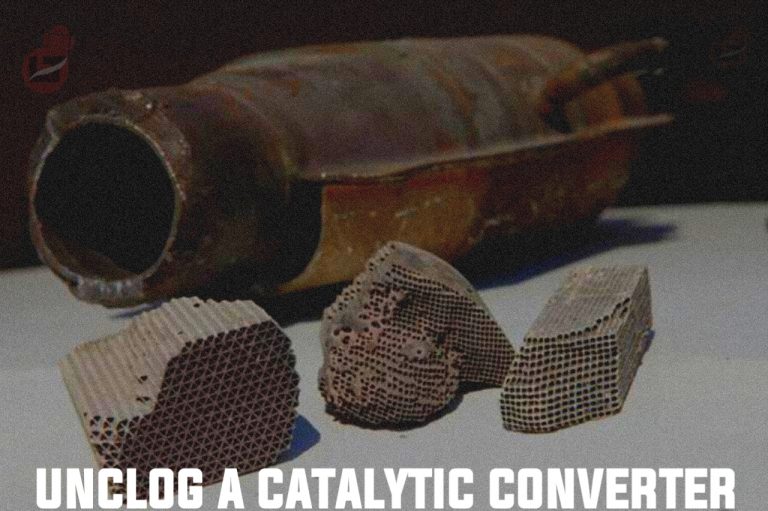If you want to learn how to unclog a catalytic converter, you’ve come to the right place. In this article, we’ll discuss the most effective and efficient methods for unclogging a catalytic converter on your own.
However, before we dive into that, it’s essential to know the symptoms of a clogged catalytic converter. This will help you confirm whether or not the problem is genuinely due to a clogged converter.
What Are the Symptoms of a Clogged Catalytic Converter?
Driving a car with a clogged catalytic converter can be troublesome due to the environmental pollution it causes and the risk it poses to your engine. Therefore, it’s crucial to recognize the symptoms of a clogged catalytic converter to avoid these problems.
1. Failed Vehicle Emission Tests
A clogged catalytic converter can cause your vehicle to fail an emissions test, one of the most common symptoms. If you notice the check engine light comes on and you need to take an emissions test, your catalytic converter is likely clogged.
This is because the catalytic converter is critical to your car’s emissions control system. When it’s not functioning correctly, emissions are not adequately controlled, and your vehicle will fail the test.
2. Engine Performance Issues
Exhaust backpressure is a common issue with a clogged catalytic converter and can affect engine performance.
When the catalytic converter is clogged, exhaust gases are trapped in the car instead of being released properly. This can impact the air-fuel mixture internal combustion engines require to start and function effectively.
As a result, starting the engine can become complicated, and even if it starts, it may sputter and stop suddenly. It is essential to address this issue promptly to avoid further damage to the engine.
3. Fuel Efficiency Issues
A clogged catalytic converter can reduce air and oxygen flow to the engine, making the car less fuel-efficient. As a result, the engine may struggle to accelerate even when the gas pedal is pressed. This puts additional strain on the engine, causing it to work harder and use more fuel.
4. Your Dashboard Lights Come On
Lastly, when the car’s dashboard warning light comes on, it could be a sign of a clogged catalytic converter.
This warning light is one of the most common indicators of a blocked catalytic converter. A blocked catalytic converter can also trigger the car’s emissions sensors, designed to detect any problems with the car’s emissions system.
How to Unclog a Catalytic Converter
This article will discuss the methods of unclogging a catalytic converter. However, before attempting any repairs, it is essential to ensure that the catalytic converter is not beyond repair or broken. If you are unsure, it is best to consult with a mechanic, as a DIY approach may not be effective.
Assuming the catalytic converter is not irreparably damaged, there are two methods of unclogging it that you can try.
1. Unclogging the Catalytic Converter by Removing It
You should adhere to simple and easy-to-understand guidelines to utilize this technique for unclogging a catalytic converter.
Here are the tools you’ll require:
- Automotive degreaser
- Large container
- Penetrating oil
- Floor jack
- Jack stands
- Impact wrench
- Pressure washer
To proceed with this method, follow the steps below:
- Allow the exhaust system to cool down to prevent burns.
- Use a floor jack to raise the car and support it with jack stands.
- Remove the oxygen sensor(s) promptly, then apply penetrating oil to loosen the bolts.
- Inspect the catalytic converter after removing it. If you hear a loud rattle, stop, as the components of the catalytic converter are most likely in pieces. If you can’t hear anything, proceed with the process.
- Clean the catalytic converter with a pressure washer at low pressure.
- Immerse the catalytic converter in hot water and degreaser.
- Rinse the catalytic converter with a pressure washer at low pressure.
- After allowing it to drain and dry, reinstall the catalytic converter.
- Reinstall the oxygen sensor(s) once the catalytic converter is back in place.
2. Unclogging the Catalytic Converter without Removing It
If your catalytic converter is only mildly clogged, you can use a catalytic converter cleaner to unclog it without removing it. This method involves cleaning your exhaust, fuel systems, and oxygen sensors and is simple to follow:
- First, ensure that you have a suitable catalytic converter for your car.
- Next, fill your tank with at least 15 litres of fuel.
- Add the catalytic converter cleaner to the fuel tank.
- Drive your car at 2500rpm for at least 30 minutes. The goal is to drive long enough for the catalytic converter/fuel mixture to circulate throughout the vehicle and clean the system. Be sure to prevent the car from overheating during the drive.
- After the drive, immediately recalibrate the OBD code, then re-read the catalytic converter.
If you notice that your car is accelerating quickly after the ride and there’s less black smoke from the exhaust, you may have successfully unclogged the catalytic converter.
This method is quick and inexpensive, but if you encounter complications while attempting to unclog your catalytic converter without removing it, consult a mechanic as soon as possible to avoid further damage.
As an Amazon Service LLC Program Associate, V. Auto Basics earns from qualifying purchases. See Our Affiliate disclaimer.
